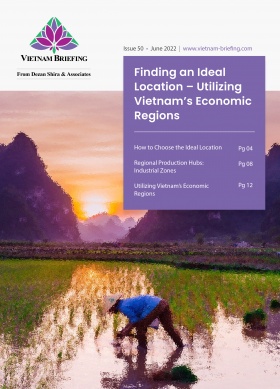Vietnam’s Energy Crunch: Coal’s Dominance and the Need for Renewables
Vietnam’s breakneck economic growth is putting pressure on its energy sources as frequent power outages burden businesses nationwide. This highlights the country’s need to source more sustainable energy sources as coal-fired power plants still dominate the national power grid.
However, with Vietnam being a net importer of coal, the country is susceptible to shifts in international supplies and prices. As such, investments in energy infrastructure and renewables are needed to reduce energy disruptions for businesses.
Vietnam has been facing an energy crunch in recent months that shows no signs of letting up.
International coal prices have spiked over the past year due in large part to the conflict in Europe, as countries scramble to secure energy sources.
As a country that is highly dependent on coal, energy instability and rising costs have contributed to energy shortages made more acute by the demands of Vietnam’s breakneck economic growth.
In the short term, Vietnam’s energy crunch will require careful management and the exploration of alternative energy sources. In the long term, however, the crunch underscores the need for Vietnam to increase its efforts in developing sustainable renewable energy capacity.
Vietnam’s coal dependence
Vietnam’s energy composition is dominated by coal, owing to its abundance and affordability. In 2020, about half of Vietnam’s energy requirements were derived from coal, followed by hydropower (30 percent), natural gas (14 percent), and non-hydroelectric renewables (5 percent).
Many advanced economies are phasing out coal because it is highly polluting. However, coal is an integral energy source for many developing countries – including Vietnam – because it is cost-effective.
Vietnam sources its coal from both domestic and international sources. Domestically, most of the country’s coal is mined in the north and is mainly undertaken by the state-owned enterprise Vietnam National Coal-Mineral Industries Corp., more commonly known as Vinacomin. Vinacomin is responsible for about 90 percent of Vietnam’s coal production.Until about a decade ago, Vietnam was a net exporter of coal, but its fast pace of economic growth and resulting power needs have turned it into a net importer. In 2020, Vietnam imported US$3.83 billion worth of coal. That year, the leading sources were Australia (50.7 percent), South Africa (18.1 percent), Indonesia (16.5 percent), and Russia (12.4 percent).
Overall, Vietnam consumed 53.52 million tons of coal in 2021, up from 38.77 million tons in 2015 and 27.8 million tons in 2011. In 2021, Vietnam imported 38.77 million tons of coal, a decrease of 33.6 percent from the previous year.
Price spikes and power outages
A series of disruptions to Vietnam’s coal supplies have caused occasional energy shortages and power outages throughout 2022, affecting both businesses and households.
Vietnam is no stranger to intermittent power supply issues. Even before the pandemic, Vietnam’s rapid growth led to annual electricity consumption increases of about 10 percent, which frequently caused cities to conduct planned outages to conserve energy supplies.
This year, however, power outages have been more frequent and disruptive. This was especially the case over the summer, as households and businesses consumed high levels of electricity to combat record-setting heat waves.
The main challenge to Vietnam’s ability to source coal is the resource’s rising cost globally. Global demand for coal has made it more difficult – and expensive – for Vietnam to procure the resource. For example, through the first four months of 2022, Vietnam’s coal imports fell by 24.5 percent year-on-year to 9.4 million tons, but the value of these imports doubled to US$2.39 billion.
In 2021, natural gas shortages and increased electricity use as economies emerged from COVID-19 restrictions led to an increase in coal prices. With demand already increasing, the price of coal doubled due to the Ukraine conflict in February 2022.
The conflict and associated sanctions on Russia have made many countries – especially in Europe – seek alternative energy sources, leading to an increase in the price of coal and other energy.
As a result of energy upheaval, many countries are bringing dormant coal plants back to life. Overall, analysts project that global investment in the supply of coal will rise by 10 percent in 2022.
In addition to high levels of electricity consumption, Vietnam’s coal supply has occasionally been disrupted by COVID-19 outbreaks in mining regions, particularly in early 2022.
Coal strategy shows the need for renewables push
To address Vietnam’s energy crunch, the government is seeking to increase its coal imports. Securing coal supplies stands to stabilize the government’s ability to meet Vietnam’s energy needs, but shines added light on the need for the country to develop renewable energy sources.
According to a draft strategy for the coal industry released by the Ministry of Industry and Trade in August 2022, Vietnam’s coal consumption is expected to rise from 94-97 million tons in 2025 to a peak of 125-127 million tons in 2030, before declining to 73-76 million tons by 2045. By 2030, coal-powered power plants are expected to produce 31 percent of Vietnam’s electricity needs.
To meet this need, Vietnam will need to import between 50 and 83 million tons of coal per year between 2025 and 2035, and then gradually lower to 32 to 35 million tons of coal per year by 2045.
The Vietnamese government’s aggressive strategy to increase coal consumption comes at the expense of its ambitious climate pledge. In November 2021, the Vietnamese government announced that the country would achieve net-zero carbon emissions by 2050. This would put Vietnam’s pursuit of carbon neutrality in a similar time frame to that of many advanced economies, despite Vietnam’s status as a developing economy.Critics, however, say that the Vietnamese government has not released a plan to steer the country towards net-zero emissions. With coal consumption increasing, Vietnam must increase investments in kind to meet climate targets.
As such, investments in areas such as renewable energy, energy infrastructure, wind power, and solar power are more needed than ever. In the immediate term, however, Vietnam’s energy security remains susceptible to shifts in international supplies and prices.
Challenges facing Vietnam’s renewable energy sector
Despite there being significant opportunities for investors in Vietnam’s renewable energy sector, infrastructure limitations are forcing the government to ask small-scale renewable energy providers to limit their operations, as the country’s transmission lines are unable to deal with the spikes in supply. This has been most prevalent among small-scale solar farms.
Also Read
- Vietnam – The Next Destination for Your Investment in Asia
- Vietnam’s Business Culture – How a Profound Understanding Will Benefit Your Business
- Vietnam’s Key Investment Industries and Destinations 2022
About Us
ASEAN Briefing is produced by Dezan Shira & Associates. The firm assists foreign investors throughout Asia and maintains offices throughout ASEAN, including in Singapore, Hanoi, Ho Chi Minh City, and Da Nang in Vietnam, Munich, and Esen in Germany, Boston, and Salt Lake City in the United States, Milan, Conegliano, and Udine in Italy, in addition to Jakarta, and Batam in Indonesia. We also have partner firms in Malaysia, Bangladesh, the Philippines, and Thailand as well as our practices in China and India. Please contact us at asia@dezshira.com or visit our website at www.dezshira.com.








